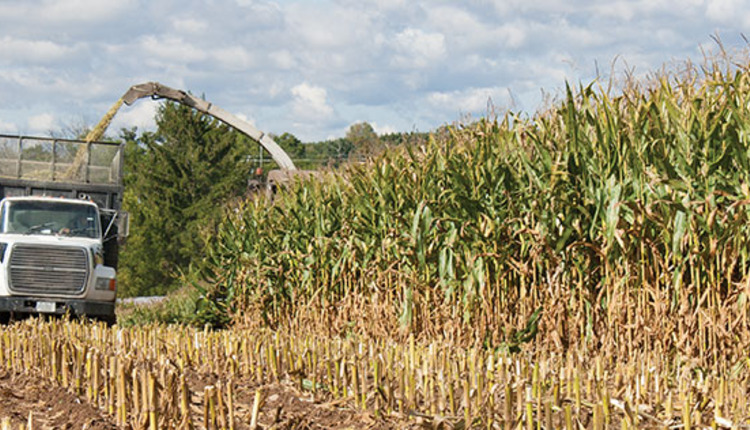Taking corn silage to new heights |
| By John Goeser |
|
|
|
The author is the director of nutrition research and innovation with Rock River Lab Inc, and adjunct assistant professor, University of Wisconsin-Madison’s Dairy Science Department.  With corn silage, heritability for nutritive quality is greater than that for hay crops due to the ability to create true hybrids from inbred lines. Hence, picking the best seed genetics is a large component in resulting quality with corn silage, but managing the corn harvest for silage is also very important. For example, dry matter and crop maturity must be optimized, and kernel processing is imperative for ideal starch digestion. In-season management decisions have a limited impact on fiber digestibility with the exception being cutting height. Cutting corn higher will raise the grain-to-stover ratio and energy content, but improving forage quality while meeting yield and inventory needs is a tricky decision. How can we evaluate what potential drawbacks or benefits could be associated with cutting corn at 12 or 18 inches instead of 6 inches from the soil surface? Considerable research has been published over the past 15 years, but how can these research results be interpreted practically and what do they mean for your farm? Lower yield . . . To help bring insight into the cut height versus yield and quality questions, I evaluated seven articles published in the past 20 years and documented 30 different treatments. After compiling the reported nutrition and yield measures for various cut heights into a spreadsheet, I developed simple prediction equations relating yield or nutrition parameters to cut height (equations not shown). Using the equations, I then predicted nutritive and yield results (see Table 1) for a normal 6-inch cut versus either 12- or 18-inch cut corn silage. When evaluating the predicted outcomes in Table 1, as cut height was elevated, yield declined, which is logical. Yield would be predicted to decrease 0.6 and 1.3 tons per acre (as-fed) for 12- and 18-inch cut heights, respectively. These ton per acre declines would result in a reduced yield value per acre of $23 and $46, respectively, assuming $35 per ton corn silage value. . . . but higher quality Beyond yield, the research-based equations suggest that corn silage value per ton at higher cuts has more starch, less fiber, and better fiber digestibility than conventionally cut corn (see Table 1). This is also logical but needs to be converted into milk per cow to estimate a return on investment. We can estimate dairy production returns by using the corn silage nutrition information within an NRC (2001) based milk prediction model. I used a ration evaluation tool to project the impact that high-cut corn silage has upon milk production potential for three different TMRs, each with corn silage cut at 6, 12, or 18 inches. The different silages, fed at 20 pounds (dry matter basis) as part of a 54 pounds of intake per cow in the TMR, projected to result in milk production gains of 0.67 and 1.3 pounds per cow, a value of $0.12 and $0.23 using $17.50 per hundredweight. Does the improved corn silage nutritional value off-set lower yield? Potentially, the milk value per acre in Table 1 suggests opportunity, but use the information presented in Table 1 at your own discretion and only as the basis for a discussion with your advisory team. Keep in mind also that moisture content will likely be different for high-cut corn silage relative to conventional cut. Moisture drops with higher cutting because the grain represents a larger proportion of the tonnage and grain is drier than stover. The lower stalk is also higher in moisture than the upper portions. High-cut corn silage may not make sense for later-season harvested corn, where whole-plant moistures have dropped below the ideal window. Perform an on-farm test When discussing potential responses with your advisory team, again consider the predictions in Table 1 and relationships with caution. The data set used to develop the predictive equations has not undergone peer review and many factors outside of cut height will impact corn silage yield and quality. Do not make decisions based on the predictions in the table. Rather, chop several test plots at different cut heights on your farm to better understand the economic ramifications with a 12- or 18-inch cut height. To evaluate high chopping potential in your fields, sample stalks at both conventional cut height and theoretical high-cut scenarios (for example, 18 inches). Sample from at least three fields and ensure your team is harvesting stalks by hand at least 30 rows in from the field edge. Using a knife or machete, hand harvest five stalks from two adjacent rows for each conventional cut height and then the desired high-cut height. Weigh each stalk set to estimate yield and then run the stalks through a chipper or chopper. Send the chopped green samples to your forage testing lab for nutritional evaluation and make sure to have a NDF (neutral detergent fiber) digestibility measure done. Upon receiving nutrition results back, work with your agronomy and nutrition advisory team to interpret and consider the yield and nutritional ramifications of high cutting. Balance the yield drag with projected nutritive quality gains to make the economic decision that benefits your farm. This article appeared in the August/September 2016 issue of Hay & Forage Grower on pages 38 and 39. Not a subscriber? Click to get the print magazine. |
